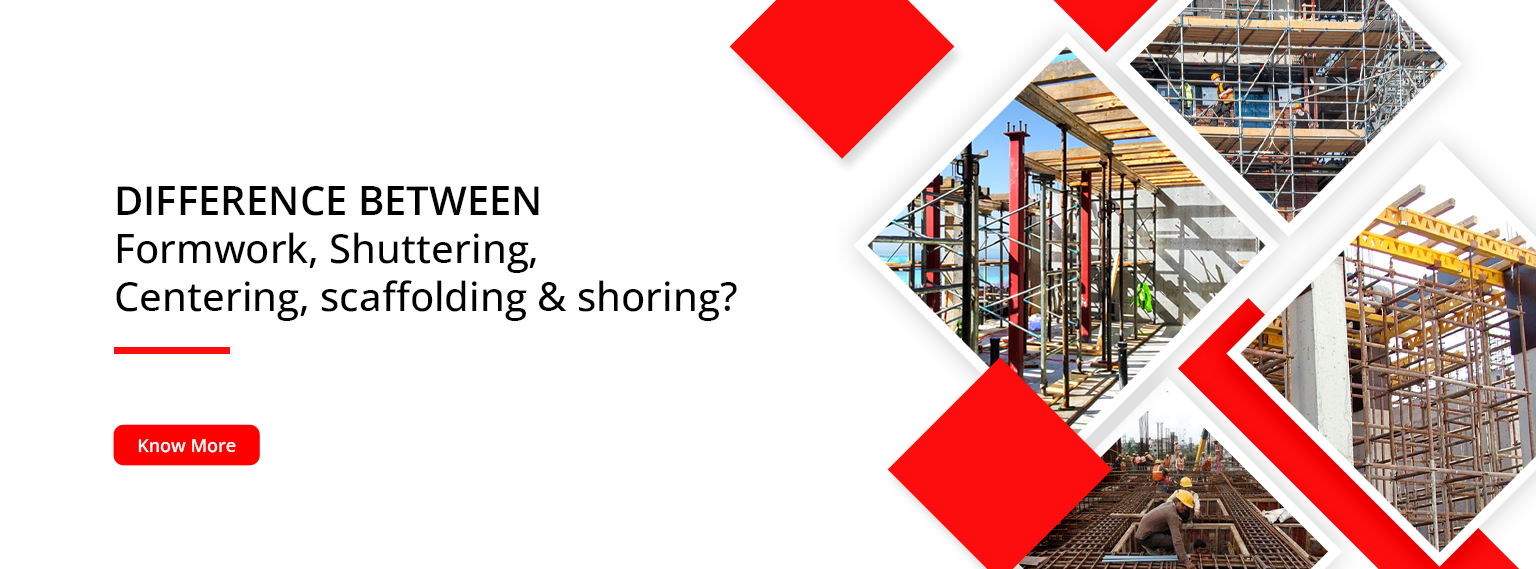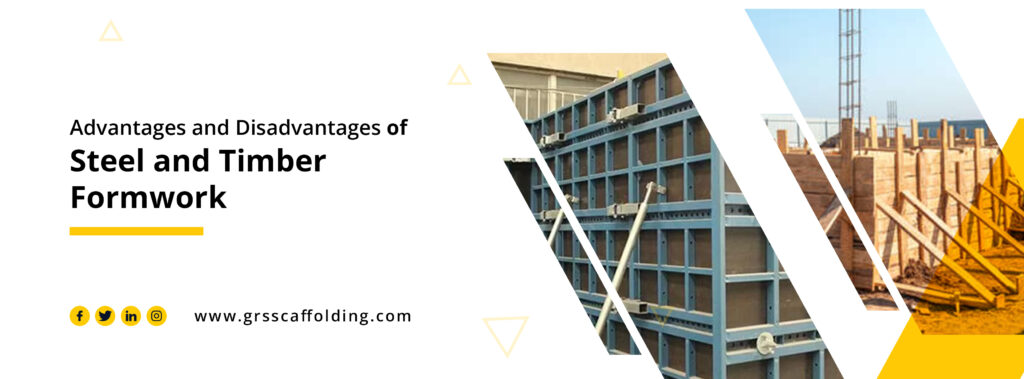In the building and engineering industries Formwork, Shuttering, Centering, shoring and scaffolding are all temporary structures which are use in construction for various purposes. Technically there are not any difference between all and you may call all these items commonly but as per their functionality these terms are categories in different form.
In this post we will look out what is the Formwork, Shuttering, Centering, scaffolding & shoring and also will look out their functionality.
What is Formwork?
In Construction Industry Formwork is just a temporary or permanent shape into which concrete is poured and hardened. Commonly formwork can be of steel, aluminium, plastic, or timber. For hundreds of thousands of years, formwork has been utilised to assist in the construction of constructions of all sizes and shapes all over the world.
Types of Formwork and Their Functionality
Steel Formwork
The builders must employ steel formwork or, in certain circumstances, plywood formwork to construct all of those concrete shapes. Formwork is a temporary framework that allows concrete to be poured and fastened while it cures. Large steel plates are fastened together with bars and couplings known as falsework in steel formwork. Because steel does not flex, warp, or otherwise become malformed during the concrete curing process, it is a suitable choice for builders.
Aluminium Formwark
Aluminium formwork is a temporary structure used in the construction industry to shape the concrete framework of a building. Other building professions, such as steel reinforcement, concrete installation, and mechanical and electrical conduits, use it as a scheduling and control system. Aluminium Formwork is perfect for load-bearing wall construction because it can withstand the high pressures of freshly poured concrete. This formwork system is versatile, lightweight, and easy to set up, making it a cost-effective option that consistently provides high-quality results.
Timber Formwork –
In all categories of formwork, timber formwork is the most commonly employed in building. It can fabricate the appropriate form and size on-site. It is simple to utilise in any building, but it may take a long time to complete major projects. The longevity of plywood formwork is limited. Timber shuttering is a low-cost, easy-to-operate shuttering option. It can be cut into any shape or size and connected together.
Plywood Formwork –
Plywood formwork is a low-cost, long-lasting, and environmentally friendly technology for producing a high-quality concrete cast surface. It’s made by layering the three specifically prepared layers on top of each other. Wherever a wide area needs to be coated with a light and durable material, plywood formwork can be used. It is particularly well suited to moulds for pouring concrete in structures.
Shuttering
Shuttering Formwork is a temporary structure that functions as a mould for new concrete, allowing it to be poured and cast in the proper shape, gain initial strength, and then harden and mature, providing building support. Traditional shutters are composed of wood, however they can also be made of steel, glass fibre reinforced polymers, and other materials. The shuttering must be robust enough to sustain dead and live loads during the concrete casting process, as well as until the concrete solidifies and reaches a percentage of the specified strength.
The building of formwork takes time and can cost up to 15% to 25% of the structure’s total cost, if not more. These temporary constructions are designed to be cost effective. Stripping refers to the process of removing the formwork. Formwork that has been stripped can be reused. Panel forms are reusable forms, while stationary forms are non-reusable.
Types of Shuttering and Their Advantage
Steel Shuttering –
Steel shuttering is made of thin steel plates that are attached to minor steel angles around the edges and for fixing the shuttering an appropriate clamp or bolts and nuts can be used together. In most bridge construction projects steel shuttering is the most crucial part of construction.
Steel shuttering is currently growing its popularity due to lengthy lifespan and you may reuses this many times but steel shuttering is expensive, it may be used for many different projects and structures like circular or curving constructions like tanks, columns, chimneys, sewers, tunnels, and retaining walls.
Advantages of steel shuttering
- It is very smooth and leveled finish.
- It is Durable and long-lasting
- It reduces the honeycombing effect.
- It is reusable more than 100 times.
- It is easy to install and uninstall.
Aluminium Shuttering
Aluminium and steel shuttering are similar shuttering but it is lighter due to low density compare to steel. As aluminium has lower density so it is also have lower strength. Before using this shuttering product you must consider their characteristics.
Dis advantage of Aluminium Shuttering
- Aluminium Shutting have low straight value
- It have higher cost value.
- You can’t use Aluminium Shuttering many times.
- It is not secure like steel shuttering.
- It is also easy to install but required more repairing.
Plastic Shuttering
Plastic shuttering are light weight formwork which are best for small construction work because it has low cost value compare to steel and aluminium formwork. Plastic shuttering are lighter in weight so it is easy to install and easy to cleaned with water. Plastic shuttering have also high reusable value but not fit with big construction work.
Advantages of Plastic Shuttering
- Plastic Shuttering are Lighter in Weight
- It is reusable more times.
- Easy to install & uninstall.
Timber Shuttering
One of the first and most popular types of formwork or Shuttering is timber shuttering but mostly timber shuttering are low secure than other shuttering. Also timber shuttering quite difficult to install and uninstall. Timber shuttering have short lifespan.
Advantage of Timber Shuttering
- It is best for low budget project.
- It has low cost value
- Easy availability
- Low maintenance cost.
- Long Readability
CENTERING
Centering formwork is an accessory construction that serves as a mould for a structure. These are temporary structures that are required to support concrete until it reaches a certain strength level.
SCAFFOLDING
Scaffolding is a term used to describe temporary structures that are used to provide a platform for workers, structural materials, and appliances needed during construction at a higher elevation (usually more than 1.5 m).
Purpose of Scaffolding
Scaffolding is a strong, durable framework placed alongside a building or other structure, such as a bridge. Work platforms are positioned at various heights and positions throughout the framework to allow workers to access multiple regions for construction or repair. Scaffolding is a makeshift structure used to elevate workers, materials, and equipment.
As the project advances, each layer of scaffolding can be added or deleted. To assist workers in moving up and down, ladders, stairs, or hoists may be used. Scaffolding is usually made up of steel and aluminum tube frames with wood planks for workers to stand on.
Types of Scaffolding
Scaffolding comes in a variety of shapes and sizes, as shown below.
- Bricklayers scaffolding or single scaffolding – Single scaffolding, which is made up of standards, ledgers, putlogs, and other components. It is frequently utilized during brick masonry work.
- Masonry scaffolding or double scaffolding – Double scaffolding is commonly used in stone masonry because it’s difficult to make holes in a stone wall for putlogs. It has a second scaffold row for support.
- Cantilever or needle scaffolding – A standard single-frame and double-frame cantilever scaffolding are supported by needles that run into the wall. It’s frequently employed when the earth doesn’t give enough support or stability, as well as for greater tiers of walls.
- Scaffolding with a ladder or a trestle – Platforms are supported by movable ladders or tripods on these mobile scaffolds. They’re typically employed indoors and in situations where regular side-to-side mobility is required.
- Scaffolding that is suspended – The scaffolding’s platforms, which can be raised and lowered, are suspended by wire ropes or chains attached to the structure’s ceiling. It’s frequently utilized when frequent upward and downward mobility is required, such as when performing specific maintenance tasks, painting, or window cleaning, for example.
Safety by Scaffolding
At construction sites, safety is always a worry. It’s critical to hire a scaffolding installation crew with the necessary training and credentials to erect and dismantle the structure securely. To avoid serious injuries and deaths, fall prevention measures must be followed.
SHORING
Shoring is the construction of temporary supports to sustain a dangerous structure.
Purpose of Shoring
Shoring systems, like scaffolds, are only temporary. They are, however, designed to sustain the structure or bridge, not the employees. Heavy-duty modular steel components make up shoring systems. Each load-bearing leg has a capacity of 50,000 to 490,000 pounds.
During building, remodeling, and demolition projects, structural shoring is used. It’s a necessary tool for jobs like bridge maintenance. Because the shoring system supports the structure’s weight, workers can safely undertake repairs without fearing the structure shifting or caving.
Types of Shoring
Shorings are grouped into three varieties based on the supporting characteristics or their placements in the space.
- Steel H or I beams – Steel H or I beams are drilled or vibrated into the earth to hold the piles in H- or I-beam shoring, which is commonly used to support excavations from 4 to 15 feet deep.
- Scant Pile Shoring – When there isn’t enough room for open excavation, a shoring wall is constructed using interlocking primary and secondary piles.
- Contiguous Pile Shoring – Contiguous pile shoring is another type of pile shoring that is commonly employed in clay soil and regions where water seepage is not an issue.
Safety by Shoring
Engineering wonders, shoring systems. Before building the shoring system, the engineer must examine elements such as the ground conditions, load factor, environment, and structure dimensions to make it as safe as possible.
In Kolkata, India, GRS SCAFFOLDING & SHUTTERING is the leading manufacturer and supplier of scaffolding products. We are a well-known company in the business that was founded with the express purpose of catering admirably to clients’ constantly changing demands.
Our primary goal is the safety of your construction crew, so we’ll collaborate closely with you to design and install a system that fulfills your requirements. We take your structural requirements and load capacity specifications into account, allowing us to create solutions for even the most difficult projects.

